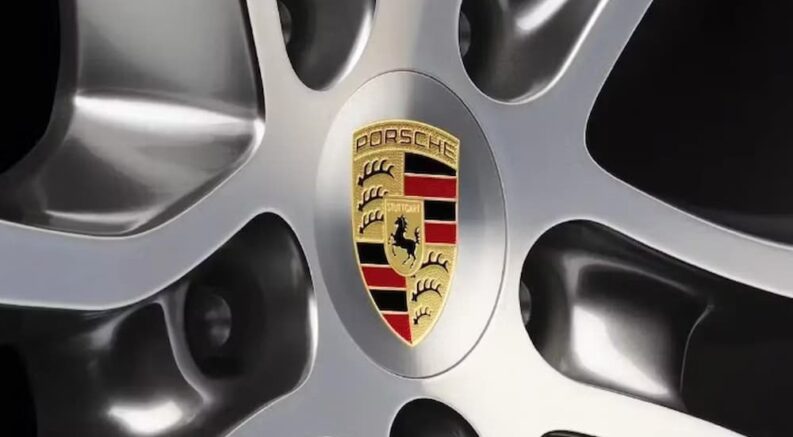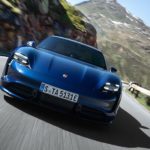Long overshadowed by the 911, the Porsche Boxster would be the standout model in almost any other automaker’s lineup. While the Boxster might not be the odds-on favorite for the title of “best sports car ever produced” like its three-digit brother, the roadster has still managed to turn quite a few heads since bursting onto the scene in 1996. In 2006 the model’s appeal was widened even further with the addition of a coupe version dubbed the Porsche Cayman. With both a coupe and cabriolet to choose from, the Porsche Boxster/Cayman has become one of the industry’s most beloved luxury sports car models. How did it get here, and what makes this German two-seater such a popular option in the crowded luxury segment?
Inspired by another iconic roadster, the Boxster boasts a colorful history that includes bringing Porsche back from the edge of financial ruin and changing the way the German brand approaches its production process. Now, over 25 years later, the Boxster is still going as strong as ever, allowing drivers to get a taste of the Porsche lifestyle without dropping $120,000 for the privilege. Let’s take a closer look at the little mid-engine sports car that could and see what makes the Boxster and Cayman such a valuable part of the Porsche lineup.
On the Brink
With a $16.1 billion valuation, Porsche is currently the world’s fifth-most valuable auto brand. But you don’t have to look that far back to find a time when the German automaker was clinging on for dear life. The year was 1993, and Porsche had only managed to move 3,000 units in the U.S. and 14,000 worldwide. Given the high-performance, luxury-focused nature of their cars, Porsche was never one of the industry’s biggest producers in terms of sheer units. Still, 14,000 is a pretty underwhelming figure no matter how you look at it, and bankruptcy was on the horizon. It was a combination of factors that landed Porsche in this dire financial position. The U.S. economy was having a bit of a hangover after the high-flying 1980s, and the automaker’s notoriously byzantine production process was leading to high prices that drivers could scarcely afford.
The solution was to introduce a new affordable model that could bring drivers into the Porsche fold without breaking the bank. The previous entry-level model, the 924/944/968, was starting to look a little long in the tooth, and Porsche knew that it was high time for a replacement. Given its precarious financial situation, the brand couldn’t afford a flop, so it looked to Mazda for a little inspiration. The Miata, released in 1989 by the Japanese automaker, was an instant sensation, satisfying the pent-up demand for an entry-level two-seat roadster. The Miata provided a promising roadmap for the struggling German automaker, but the company knew that they needed to put their own Porsche-like twist on the Miata concept. After all, this is Porsche we’re talking about, and the storied brand didn’t get where it was by rolling out knockoffs of existing models.
Porsche found this twist in the form of a mid-engine design. The hallmark of any good high-performance model, a mid-engine design allows engineers to better balance the weight between the front and rear of the vehicle. This confers some rather substantial benefits when it comes to performance, improving traction and allowing the Boxster to maintain its stability through corners. It also keeps the engine in the back of the car where it “belongs,” according to Porsche purists who preferred the rear-engine 911 and discounted front-engine models like the 944 and 928 as not being a “real” Porsche. The Boxster wouldn’t be Porsche’s first mid-engine model, but it would be the first in almost 50 years stretching back to the 550 Spyder of the mid-1950s.
“The mid-engine concept offered a high potential for optimal dynamic performance and is typical for sports cars—hence, it was a good fit for Porsche,” said lead Boxster development engineer Hans-Juergen Woehler in a 2016 interview. “The segment for roadsters was growing when the [Boxster] was conceived and developed, so it proved to be an opportune time to enter it.”
Building the Boxster
Porsche might have had a great concept for its new mid-engine roadster, but logistics were another story. If the Boxster was to be a success, Porsche would have to figure out a way to smooth out the production issues that had plagued the company through the early 90s. Once again, the brand looked to a Japanese company for inspiration, hiring former Toyota engineers to implement the “just-in-time” production method that had proved so fruitful for the Asian automaker.
Designed to reduce inefficiencies and errors, the just-in-time method involves building and procuring parts when and where they’re needed instead of stocking up on every single nut and bolt well in advance. It was a major change for the historically disorganized automaker, which was notorious for its rather ad-hoc approach that saw engineers searching parts bins and warehouse shelves for parts while trying to build a single vehicle. The technique worked, allowing Porsche to reduce the average assembly time from 120 hours down to 72 while reducing overall errors by 50 percent. The implementation of the just-in-time production method, along with sharing parts designed for the upcoming 996 version of the 911, allowed Porsche to dramatically reduce the cost of production, a crucial factor in making the Boxster feasible from a financial standpoint.
The world got its first look at the Boxster at the 1993 Detroit Auto Show when Porsche unveiled the Boxster Concept. In a nod to the brand’s heritage, the concept model would borrow many styling cues from the brand’s previous mid-engine model in the 550 Spyder. The name, which was a combination of “boxer” and “roadster,” reflected the model’s sporty two-seat design and the fact that it used a six-cylinder boxer-style engine. The concept would prove a hit, and the Boxster would make its real-world debut in 1996.
Powered by a 2.5L water-cooled boxer-6 engine, the first-generation Boxster only made 200 horsepower. This number would steadily climb throughout the roadster’s successive generations. Available with a five or six-speed manual transmission or a Tiptronic automatic, it was the Boxster’s styling that turned heads. The roadster’s front end, including the fenders and headlights, was remarkably similar to that of the forthcoming 911, allowing drivers to induce 911-level jealousy on a Boxster budget. The Boxster would quickly become Porsche’s best-selling model, a title it would hold until the uber-popular Cayenne SUV debuted in 2003.
Porsche would continue to refine the Boxster formula over the years, introducing a 3.2L Boxster S in 2000 that upped the horsepower by a considerable margin, giving drivers 258 ponies to play with. The second generation upped the power ever further with a base model type 987 Boxster making 236 horsepower, and the new 3.4L Boxster S cranking out just under 300 horsepower.
Enter the Cayman
Given the success of the Boxster, it was only a matter of time before Porsche introduced a hardtop version. That moment came in 2006 with the debut of the Cayman. Named after an obscure member of the alligator family, the Cayman allowed Porsche to extend the Boxster’s dominance to the world of hardtop sports cars. Aside from a little added structural strength to accommodate the fixed roof design, the Cayman is virtually identical to the second and third-generation Boxster on which it’s based.
Porsche wasn’t done tinkering just yet. The 2008 Boxster RS 60 Spyder would be the first version to break the 300-horsepower mark, which, combined with the addition of Porsche’s Active Suspension Management and revised exhaust system, made the model one of the most exciting to date. In an attempt to keep up with increasingly powerful offerings from Nissan and the like, Porsche added direct fuel injection and a seven-speed PDK dual-clutch automated manual gearbox to the 2009 Boxster, giving the base model 255 horsepower and the high-performance Boxster S over 310.
The third-generation model improved on the Boxster even further in 2013, improving fuel economy while reducing its weight, revising the suspension, and, of course, making some all-important styling changes. A new engine, paired with the Boxer’s first-ever six-speed manual transmission, increased the power output of the standard model to 265 horsepower, while the S model produced more than 315. If a 315-horsepower, 2,900-pound roadster doesn’t sound fast enough, Porsche unveiled a rubber-burning GTS trim in 2015 powered by a 3.4L engine capable of achieving 330 horsepower. The 981 Spyder would be the third-generation Boxster’s ultimate incarnation, with most of the credit going to the 911 Turbo-inspired steering system, brakes, and 3.8L engine lifted from the Carrera S, the largest engine to ever find its way under a Boxster’s hood. With a top speed of 180 mph and some clever weight-saving modifications, the Boxster would almost rival the 911 in terms of power. That said, the 981 Spyder represents a bittersweet moment in Boxster history. While it was undeniably powerful, it was also the last Boxster to feature a six-cylinder engine, owing to tightening emissions standards.
A New Era
While the end of the third-generation Boxster might have spelled the end of the six-cylinder engine, that doesn’t mean an end to the fun. Thanks to a little forced induction, Porsche has managed to make the fourth generation just as thrilling as ever, despite an overall reduction in cylinders and displacement. The Boxster 718 hit the street in 2016, offering drivers some 300 horsepower and 280 lb-ft of torque despite the smaller 2.0L boxer-4 engine. The turbocharged 2.5L Boxster S ups the ante with 350 horsepower and 309 lb-ft of torque, giving both fourth-generation Boxster models 35 more horsepower than their six-cylinder ancestors. The base model receives a standard turbocharger with a conventional internal wastegate, while the S version employs an advanced variable turbine geometry (VTG) turbocharger. Designed with an adjustable stator vane ring above the turbine wheel to control the exhaust gas mass flow, the VTG gives the turbocharger’s turbine more efficiency across a wider engine operating range.
Despite the increase in power and comparable performance, some die-hard Porsche fans weren’t exactly thrilled about the departure of the six-cylinder engine. This pushback led Porsche to reintroduce the flat-six in 2019 in the form of the Boxster Spyder and GT4, which was graced with a 4.0L boxer-6 engine producing a Boxster-record 414 horsepower. For those who think that 414 horses might be a little excessive in a 3,000-pound roadster, there’s always the Boxster GTS 4.0, which provides a slightly more manageable 396 horsepower.
The Boxster is still going strong, with the 2024 model earning plenty of praise from the automotive press. The mid-engine sports car was dubbed “a sports car masterpiece, with crisp handling and a superbly balanced chassis” by Car and Driver, which also ranks the Boxster as the second-best performance sports car after only the Chevy Corvette. The engine lineup remains the same as earlier fourth-generation models, but 2024 does see the addition of a special Style Edition model that adds 20-inch wheels, hood and door graphics, limited edition floor mats, illuminated door sill plates, and more. The Style Edition largely serves as a showcase for the new Ruby Star Neo paint color, which gives the Boxster a slick, fuschia-like color scheme that’s sure to turn some heads.
The Boxster might no longer be Porsche’s best-selling model, but its role in the company’s history can’t be ignored. Without the Boxster, Porsche as we know it might not exist, which makes the roadster one of the most important models in Porsche’s almost 100-year history. The Boxster has gone through a lot of changes over the years, but it remains a Porsche through and through. If you’re in the market for a heart-pounding ride that’s heavy on style, the Boxster is definitely worth a test drive. For those seeking a more practical year-round option, or perhaps a track car, the Cayman also deserves a closer look. The 911 might be the undisputed icon of the Porsche lineup, and versatile SUV models like Cayenne and Macan have proven to be exceptionally popular as of late, but if you’re looking to break into the world of Porsche without spending a fortune, the Boxster and Cayman are worthy candidates. While they might represent two of the most affordable models available, there’s nothing entry-level about the driving experience these sports cars provide.




